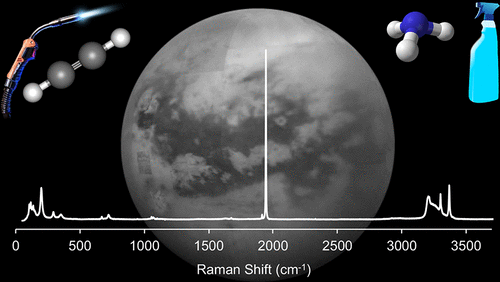当前位置:
X-MOL 学术
›
ACS Earth Space Chem.
›
论文详情
Our official English website, www.x-mol.net, welcomes your feedback! (Note: you will need to create a separate account there.)
The Acetylene-Ammonia Co-crystal on Titan
ACS Earth and Space Chemistry ( IF 3.4 ) Pub Date : 2018-02-27 00:00:00 , DOI: 10.1021/acsearthspacechem.7b00135 Morgan L. Cable 1 , Tuan H. Vu 1 , Helen E. Maynard-Casely 2 , Mathieu Choukroun 1 , Robert Hodyss 1
ACS Earth and Space Chemistry ( IF 3.4 ) Pub Date : 2018-02-27 00:00:00 , DOI: 10.1021/acsearthspacechem.7b00135 Morgan L. Cable 1 , Tuan H. Vu 1 , Helen E. Maynard-Casely 2 , Mathieu Choukroun 1 , Robert Hodyss 1
Affiliation

|
Titan, the largest moon of Saturn, likely supports a rich organic mineralogy that we are only beginning to understand. Photochemistry in the upper atmosphere generates a complex array of organic molecules from the simple precursors N2 and CH4. These organics continue to react and combine, forming aerosol layers and ultimately depositing on the surface. Organics are transported via pluvial (rain) and fluvial (rivers/flooding) processes into the methane-based hydrocarbon lakes, where evaporation of volatile liquids can create evaporite deposits of remnant dissolved molecules. Within such deposits, chemical and physical processes may be occurring even at low temperatures. We have demonstrated in previous work that benzene and ethane rapidly form a unique and stable co-crystal at Titan surface temperatures (90–95 K), akin to a salt on Earth, where the weak van der Waals interactions in the benzene-ethane co-crystal are analogous to the ionic bonds in a salt. Here, we report the formation of a second co-crystal between acetylene and ammonia, which forms even more quickly and is stable through anticipated conditions of Titan “rain” events of liquid methane, ethane, and propane. Such co-crystals represent an exciting new class of possible minerals for Titan’s surface and may be responsible for processes such as selective sequestration and storage of species as well as having new properties for construction and erosive resistance of geological materials.
中文翻译:

土卫六上的乙氨共晶
土星最大的卫星泰坦(Titan)可能支持我们才刚刚开始了解的丰富的有机矿物学。高层大气中的光化学从简单的前体N 2和CH 4生成复杂的有机分子阵列。这些有机物继续反应并结合,形成气溶胶层并最终沉积在表面上。有机物通过小雨(河流)和河流(河流/洪水)过程被输送到基于甲烷的碳氢化合物湖中,其中挥发性液体的蒸发会形成残留溶解分子的蒸发岩沉积物。在此类沉积物中,即使在低温下也可能发生化学和物理过程。我们在先前的工作中已经证明,苯和乙烷在土卫六表面温度(90–95 K)下迅速形成独特而稳定的共晶体,类似于地球上的盐,其中苯乙烷中的弱范德华相互作用-晶体类似于盐中的离子键。在这里,我们报告了乙炔和氨之间形成了第二个共晶,在液化甲烷,乙烷和丙烷的泰坦“雨”事件的预期条件下,其形成速度甚至更快并保持稳定。这种共晶代表了土卫六表面上令人兴奋的一类可能的矿物,并且可能负责诸如选择性螯合和存储物种以及对地质材料的构造和抗侵蚀性具有新特性的过程。
更新日期:2018-02-27
中文翻译:

土卫六上的乙氨共晶
土星最大的卫星泰坦(Titan)可能支持我们才刚刚开始了解的丰富的有机矿物学。高层大气中的光化学从简单的前体N 2和CH 4生成复杂的有机分子阵列。这些有机物继续反应并结合,形成气溶胶层并最终沉积在表面上。有机物通过小雨(河流)和河流(河流/洪水)过程被输送到基于甲烷的碳氢化合物湖中,其中挥发性液体的蒸发会形成残留溶解分子的蒸发岩沉积物。在此类沉积物中,即使在低温下也可能发生化学和物理过程。我们在先前的工作中已经证明,苯和乙烷在土卫六表面温度(90–95 K)下迅速形成独特而稳定的共晶体,类似于地球上的盐,其中苯乙烷中的弱范德华相互作用-晶体类似于盐中的离子键。在这里,我们报告了乙炔和氨之间形成了第二个共晶,在液化甲烷,乙烷和丙烷的泰坦“雨”事件的预期条件下,其形成速度甚至更快并保持稳定。这种共晶代表了土卫六表面上令人兴奋的一类可能的矿物,并且可能负责诸如选择性螯合和存储物种以及对地质材料的构造和抗侵蚀性具有新特性的过程。


























 京公网安备 11010802027423号
京公网安备 11010802027423号